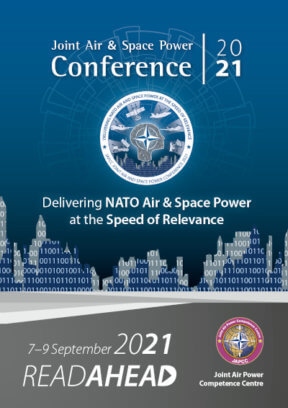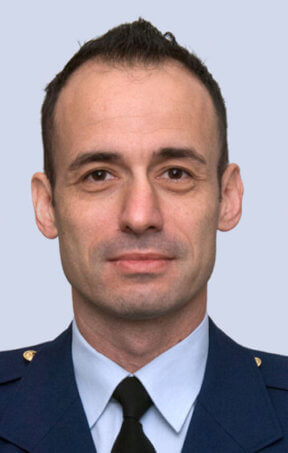Introduction
In a world of greater competition, future peer adversary capabilities, including the threat posed to Alliance platforms from Air defence systems, will continue to develop and increase in lethality at a relentless pace. The concept of uncontested operating environments has been replaced by the new paradigm of a contested environment defended by adversary Anti Access Area Denial (A2/AD) capabilities. NATO must adapt to this new norm and acknowledge a new threat environment where ‘speed’ is crucial. The pivotal question now is how do Alliance military preparations and operations need to adapt to effectively respond to these evolving threats, while simultaneously ensuring the risks remain manageable and NATO’s limited resources used synergistically, efficiently, and effectively to provide Air and Space Power at the Speed of Relevance. Alliance commanders will be asked to make effective responses to the operational environment’s broad range of challenges and address future dynamic conflicts with a new mindset.
Decision-making and dynamic targeting cycles will be conducted with limited time and information. These conditions will greatly disturb the traditional Command and Control (C2) dynamics. To increase the speed of decision-making of joint forces’ C2 and to increase survivability in the battlespace against peer adversaries’ threats, the Alliance will require synchronized, interoperable, and resilient C2 structures across all domains. Without changing the basic principles of C2, new technologies and their associated change to operational dynamics are needed to harmonize the Alliance C2 structure. Some of these new technologies include enhanced satellite communications technologies, Artificial Intelligence (AI), Machine Learning (ML), Big Data Management, modelling of Human-On-the-Loop, Human-In-the-Loop, and Human-Out-Ofthe-Loop through command cycles, and digital connectivity features. There also exists a requirement for well-trained personnel grounded in the fundamental C2 concepts to harmonize the Alliance C2 structure. In this context, while this panel aims to present a different perspective on the basic issues presented above, it also aims to sketch out a roadmap for what to do in the NATO C2 Concept for the upcoming development period.
Transitioning to a New Era of C2
The NATO 20301 initiative assesses the main trends that will shape NATO’s environment between now and 2030. It outlines that NATO’s external security environment has changed dramatically since 2010, and in this emerging decade of renewed systemic rivalry and growing transboundary threats and risks, highlights that a functioning and robust NATO military command structure will be more important to the security of Alliance.
Additionally, NATO’s Strategic Foresight Analysis (SFA)2 provides a predictive view of the world’s strategic trends out to and beyond 2035; it presents a vision of political, social, technological, economic, and environmental trends. It concludes that asymmetric conflict scenarios will continue and surmises that the need for collective defence against a peer or near-peer adversary will increase. It also points out that to keep our military edge, prevail in future operations and to face peer and near-peer opponents in all domains, Alliance forces will need resilient, adaptable and interoperable C2 systems to provide awareness and a 360-degree, 24/7 operational picture, across all domains. It also suggests that we will require the ability to overcome A2/AD environments and hybrid threats.
Today’s military operations are becoming more complicated with the rise in the number and variety of commanders’ options at all levels of the organization. The expansion of military activity beyond the Air, Sea, and Land domains to Space and Cyberspace has broadened the community of warfighters that modern militaries require to operate successfully and efficiently in the battlespace. As the changing character of war becomes enmeshed in the digital age, future conflicts will be decided by those who are the fastest at collecting, correlating, fusing, analyzing, and securely transporting the right decision quality data across multiple domains to the appropriate decision-maker.3 Having the ability to operate in all domains creates more vital opportunities for commanders to employ their forces strategically against peer adversaries. However, this ability requires interoperability and the detailed integration of all domains. Often, much of the available data is not relevant to most users. There must be some guidelines on who gets what information. Information technology must enable the decision-maker in the future to access high-quality information, which is relevant at a specific moment in time and to his or her specific position within the C2 organization. C2 is not just about situational awareness, it is also about how and by whom decisions are made. Dynamic, real-time information sharing and networking are critical for establishing full operational capabilities and facilitating these exchanges. Simultaneously, multiple-domain or all domain operations create additional command and control load and bring responsibilities such as training, education, manning, and require institutionalizing policies by their nature.
Perhaps the only way to eliminate such problems before they arise is to strengthen jointness across all domains and services. Traditionally, the concept of Jointness is defined as different fighting services that are working with and supporting each other. Another point of view regarding Jointness is that ‘Jointness is not created by doctrine, joint or otherwise. It is brought about by people, good and bad. Like most things in life, it is created more successfully by having a higher proportion of professional people well trained in their service capabilities and how to employ them.’4 The intent is to at least provide ‘Jointness’ in concepts, organizational constructs and training.
One of the new approaches for this purpose is Joint All Domain Command, and Control (JADC2). Joint All-Domain Operations (JADO) are those actions taken by the joint forces of two or more NATO nations, comprised of all appropriate domains, integrated in planning and synchronized in execution, at a pace sufficient to effectively accomplish the mission.5 To win future battles, the side with an information advantage across multiple domains will undoubtedly have decisive advantages. It is essential to ensure that the right information is available to the right decision-maker at the right place and time. A resilient JADC2 architecture would enable commanders to understand the battlespace more rapidly, direct forces faster than the peer adversary, and deliver synchronized combat effects across multiple domains.6
Legacy C2 Dependency
C2 tasks traditionally include establishing the command hierarchy, authority allocation and delegation, planning, allocating resources, assigning, and managing functions through mission objectives. Occasionally, military decision-makers are dependent on legacy C2 systems impeded by multiple barriers, including those between classification levels, separate services, and Alliance capability disparities. In addition, the accelerated emphasis on improved Cyberspace and Space integration has placed new functional and technical demands on C2 systems. Synchronization at the speed of decision-making and timing is sometimes challenging, if not impossible. This C2 dependency could be minimized by developing new technologies, fielding new capabilities and enhancing interoperability bet ween services and nations. New technologies should be pursued, especially for use in contested environments, to make the communications chain and data exchange more resilient. Sometimes, other than the technological mitigations for challenged C2, the next best option might be to find procedural and organizational mitigations to cover the technical shortcomings and execute distributed control of critical missions when required. The transition of operations from uncontested to contested environments and the preparation for high-end conflicts against peer adversaries has created the need to change the highly centralized C2 of Air operations. Creating more C2 nodes and handing over more responsibilities to subordinates via mission-type orders can help achieve the commander’s intent in contested environments. A mobile and robust adversary and its highly resilient assets will characterize the contested battlespace environment of the future. These conditions create a need to increase the scale of information processing. The combination of imminent threats to the joint force, the limited time of battlespace access due to area denial systems, and the increased use of standoff weapons will shorten the decision time available. The current C2 of the dynamic targeting construct is not adequate to achieve the speed of tactical decisions required in this operational context. Allies should explore flexible C2 models that will allow for the maximum amount of effective decentralization.7
Those options require significant changes in the traditional approach to C2, including renovating the organizational structure, qualified manning and assignments, training, and leveraged C2 technologies. However, in the time-constrained and contested environment, the target-strike decision might need to be made closer to the source of target detection, like from an Unmanned Aircraft System (UAS), with the help of subordinate Tactical Command and Control (TAC C2). Planners should explicitly clarify the delegation of authority and the degree of control before establishment of the mission plan and execution of operations.
The design of distributed C2 should be based on an analysis of risk factors, such as feasibility, inefficiencies, costs, resources, and threats by peer adversaries. Whatever the implementation, various investments in new technologies and practices will be necessary to evolve from centralized C2 physical centres. AI/ML can help enable this shift to distributed control, for example, by providing predictive tools (e. g., for force readiness at a wing operations centre), dynamic courses of action generation at a subordinate node, and decision tools for commanders at forward operating nodes.8
Additional Articles
This section presents five related articles which will introduce various ideas and perspectives related to the dynamic C2 synchronized across domains and the current challenges NATO faces therein. The ideas expressed in these articles are meant to inspire critical thinking to prepare those attending the 2021 Joint Air & Space Power conference for the panel discussion Dynamic Command and Control Synchronized across Domains:
- Lieutenant General Fernando De La Cruz Caravaca (SP Air Force) provides a senior leader’s perspective on the idea of Dynamic C2 Synchronized Across Domains. As the Commander of the NATO Combined Air Operation Centre – Torrejón, he provides unique insights into the current environment, discusses new technologies and threats, and shares his thoughts on multi-domain C2, dynamic and synchronized.
- In Is Human-On-the-Loop the Best C2 Architecture to Deliver Rapid Relevant Responses (R3)?, Dr Michael Cowen, Captain (ret.) Rick Williams (US Navy), and Brigadier General (ret.) Doug Cherry (US Army) discuss the comparison between Human-On-the-Loop, Human-In-the-Loop, and the progression to Human-Out-Of-Loop. The paper also discusses the supervisory control capabilities, requirements, and issues implicit in each human in/on/out of the loop architecture to safely deliver Rapid Relevant Responses (R3) as cycle time approaches zero to reduce the probability of a robot war incident.
- The next paper Technology and Connectivity: an essential bond for a modern Air Force is written by Major Ferdinando Pagano (IT Air Force). This paper focuses on modern Air Power challenges and complexities and the linkage between technologies and digital connectivity to operate efficiently across all domains.
- Colonel (ret.) Hubert Saur’s (GE Air Force) Multi-Domain Combat Cloud – A Vision for the Future Battlefield appears next in the booklet. The paper articulates that future warfighting will require a far higher degree of processing, automation, and integration throughout the Mission Cycle. To tackle these challenges, this paper argues on behalf of a MultiDomain Combat Cloud solution to enable forces to Be Informed as One and Act as One.
- This topic NATO Command and Control Resilience in Contested Environments by Ms Clementine G. Starling and Mr Owen J. Daniels presents the ongoing C2 challenges for NATO and possible approaches for improving C2 resiliency. The paper goes into JADC2 concept, and how or why NATO Allies consider similar concepts to bolster combat effectiveness, ensure integration, and maintain interoperability against degraded C2.
- Human-On-the-Loop is a collaborative work by Colonel (ret.) Thomas Vincotte (FR Air Force), Brigadier General (ret.) Jean Michel Verney (FR Air Force), and Mr Laurent le Quement. This paper discusses new innovative technological approaches where software, artificial intelligence, automation, and satellite communications will bypass human limitations. The paper also touches upon a strong link that exists between the amount of information to be processed, the tempo, and the position of humans in the decision process.









